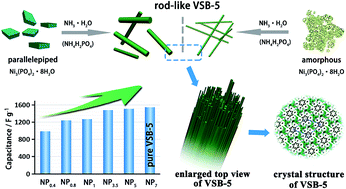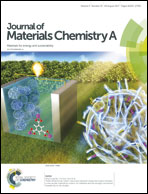From understanding the formation mechanism to enhanced supercapacitor performance of VSB-5 with a hierarchical structure†
Abstract
Understanding the formation mechanism of electrode materials is critical to control their structure and optimize the electrochemical performance for supercapacitors. However, few reports have focused on the formation mechanism of nickel phosphate VSB-5 (Ni20[(OH)12(H2O)6][(HPO4)8(PO4)4]·12H2O) and its application in the electrochemical field. Here, by controlling the addition amount of aqueous ammonia, rod-like VSB-5 with a hierarchical structure was obtained via a simple hydrothermal method without any structure-directing agents. Importantly, we propose that VSB-5 can be obtained by the transformation of Ni3(PO4)2·8H2O, and well confirm this by re-adding NH4H2PO4 to a mixture containing rod-like VSB-5 and Ni3(PO4)2·8H2O with different structures. Benefitting from the understanding of the formation mechanism, hierarchical rod-like VSB-5 with small particle sizes can be obtained which delivers a high capacitance of 1542.0 F g−1 at a current density of 0.5 A g−1. To further verify its practical application, a hybrid supercapacitor device with a wide potential window of 1.6 V by using VSB-5 as the positive electrode and the 3D reduced graphene oxide hydrogel as the negative electrode was assembled, which exhibits a remarkable energy density of 42.4 W h kg−1 with excellent cycling stability (98.3%, 10 000 cycles).



 Please wait while we load your content...
Please wait while we load your content...